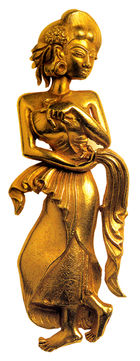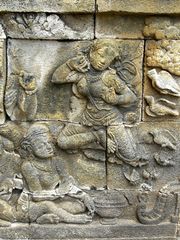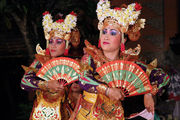Apsara

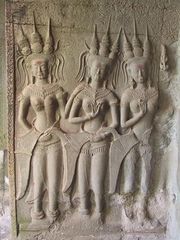
An Apsara (Sanskrit: अप्सराः apsarāḥ, plural अप्सरसः apsarasaḥ, stem apsaras-, a feminine consonant stem), Apsara (អប្សរា) or Tep Apsar (ទេពអប្សរ) in Khmer, Accharā (Pāli) or A Bố Sa La Tư (Vietnamese), Bidadari (Malay, Indonesian, Tausug languages), and Apson (Thai: อัปสร), also known as Vidhya Dhari, is a female spirit of the clouds and waters in Hindu and Buddhist mythology. English translations of the word "Apsara" include "nymph," "celestial nymph," and "celestial maiden."
Apsaras are beautiful, supernatural women. They are youthful and elegant, and proficient in the art of dancing. They are the wives of the Gandharvas, the court servants of Indra. They dance to the music made by their husbands, usually in the palaces of the gods, and entertain gods and fallen heroes. As caretakers of fallen heroes, they may be compared to the valkyries of Norse mythology.
Apsaras are said to be able to change their shapes at will, and rule over the fortunes of gaming and gambling. Urvasi, Menaka, Rambha and Tilottama are the most famous among them. Apsaras are sometimes compared to the muses of ancient Greece, with each of the 26 Apsaras at Indra's court representing a distinct aspect of the performing arts. Apsaras are associated with water; thus, they may be compared to the nymphs, dryads and naiads of ancient Greece. They are associated with fertility rites.
Contents |
Apsaras in ancient literature
Rig Veda
The Rig Veda tells of an Apsara who is the wife of Gandharva; however, the Rig Veda also seems to allow for the existence of more than one Apsara. The only Apsara specifically named is Urvashi. An entire hymn deals with the colloquy between Urvashi and her mortal lover Pururavas.[1] Later Hindu scriptures allow for the existence of numerous Apsaras, who act as the handmaidens of Indra or as dancers at his celestial court.
Mahabharata
In many of the stories related in the Mahabharata, Apsaras appear in important supporting roles. The epic contains several lists of the principal Apsaras, which lists are not always identical. Here is one such list, together with a description of how the celestial dancers appeared to the residents and guests at the court of the gods:
"Ghritachi and Menaka and Rambha and Purvachitti and Swayamprabha and Urvashi and Misrakeshi and Dandagauri and Varuthini and Gopali and Sahajanya and Kumbhayoni and Prajagara and Chitrasena and Chitralekha and Saha and Madhuraswana, these and others by thousands, possessed of eyes like lotus leaves, who were employed in enticing the hearts of persons practising rigid austerities, danced there. And possessing slim waists and fair large hips, they began to perform various evolutions, shaking their deep bosoms, and casting their glances around, and exhibiting other attractive attitudes capable of stealing the hearts and resolutions and minds of the spectators."[2]
Exploits of individual Apsaras
The Mahabharata documents the exploits of individual Apsaras, such as Tilottama, who rescued the world from the rampaging asura brothers Sunda and Upasunda, and Urvashi, who attempted to seduce the hero Arjuna.
The Nymph and the Sage
A story type or theme appearing over and over again in the Mahabharata is that of an Apsara sent to distract a sage or spiritual master from his ascetic practices. One story embodying this theme is that recounted by the epic heroine Shakuntala to explain her own parentage.[3] Once upon a time, the sage Viswamitra generated such intense energy by means of his asceticism that Indra himself became fearful. Deciding that the sage would have to be distracted from his penances, he sent the Apsara Menaka to work her charms. Menaka trembled at the thought of angering such a powerful ascetic, but she obeyed the god's order. As she approached Viswamitra, the wind god Vayu tore away her garments. Seeing her thus disrobed, the sage abandoned himself to lust. Nymph and sage engaged in sex for some time, during which Viswamitra's asceticism was put on hold. As a consequence, Menaka gave birth to a daughter, whom she abandoned on the banks of a river. That daughter was Shakuntala herself, the narrator of the story.
Natya Shastra
Natya Shastra, the principle work of dramatic theory for Sanskrit drama, lists the following apsaras: Manjukesi, Sukesi, Misrakesi, Sulochana, Saudamini, Devadatta, Devasena, Manorama, Sudati, Sundari, Vigagdha, Vividha, Budha, Sumala, Santati, Sunanda, Sumukhi, Magadhi, Arjuni, Sarala, Kerala, Dhrti, Nanda, Supuskala, Supuspamala and Kalabha.
In the visual arts
Apsaras in the art of ancient Java and Bali, Indonesia
Images of Apsaras are found in several temples of ancient Java dating from the era of the Sailendra dynasty to that of the Majapahit empire. Usually they are not found as decorative motifs but as integral parts of a story in bas-relief, as for example at Borobudur, Mendut, Prambanan, Plaosan, and Penataran. At Borobudur apsaras are depicted as divinely beautiful celestial maidens, pictured either in standing or in flying positions, usually holding lotus blossoms, spreading flower petals, or waving celestial clothes as if they were wings enabling them to fly. The temple of Mendut near Borobudur depicted groups of devatas, divine beings flying in heaven, which included apsaras.
Traditionally apsaras are described as celestial maidens living in Indra's heaven (Kaéndran). They are well known for their special task: being sent to earth by Indra to seduce ascetics who by their severe practices may become more powerful than the gods. This theme occurs frequently in Javanese traditions, including the "Kakawin Arjunawiwaha", written by mpu Kanwa in 1030 during the reign of king Airlangga. The story tells that Arjuna, in order to defeat the giant Niwatakawaca, engaged in meditation and asceticism, whereupon Indra sent apsaras to seduce him. Arjuna, however, managed to conquer his lust and then to win the ultimate weapons from the gods to defeat the giant.
Later in the Javanese tradition the apsara was also called Hapsari, also known as Widodari (from sanskirt word Vidhyadhari, vidhya: knowledge, dharya: having, bearer, or bringer), and finally known as Bidadari in the modern Indonesian language (the same form of the word is now present in the Malay language, as well). The Javanese Hindu-Buddhist tradition also influenced Bali. In Balinese dance the theme of celestial maidens often occurred. Dances such as Sanghyang Dedari and Legong depicted divine maidens in their own way. In the court of Mataram Sultanate the tradition of depicting heavenly maidens in dances still alive and well. The Javanese court dances of Bedhaya portray apsaras.
Apsaras in the art and architecture of Cambodia


Apsaras represent an important motif in the stone bas-reliefs of the Angkorian temples in Cambodia (8th-13th century AD), however all female images are not considered to be apsaras. In harmony with the Indian association of dance with apsaras, Khmer female figures that are dancing or are poised to dance are considered apsaras; female figures, depicted individually or in groups, who are standing still and facing forward in the manner of temple guardians or custodians are called devatas.[4]
Angkor Wat, the largest Angkorian temple built (1116-1150 AD), features both apsaras and devata, however the devata type are the most numerous with more than 1,796 in the present research inventory.[5] Angkor Wat architects employed small apsara images (30-40cm as seen at left) as decorative motifs on pillars and walls. They incorporated larger devata images (all full-body portraits measuring approximately 95-110cm) more prominently at every level of the temple from the entry pavilion to the tops of the high towers. In 1927, Sappho Marchal published a study cataloging the remarkable diversity of their hair, headdresses, garments, stance, jewelry and decorative flowers, which Marchal concluded were based on actual practices of the Angkor period. Some devata appear with arms around each other and seem to be greeting the viewer. “The devatas seem to epitomize all the elements of a refined elegance,” wrote Marchal.[6]
Khmer Classical Dance
Khmer classical dance, the indigenous ballet-like performance art of Cambodia, is frequently called "Apsara Dance". This appellation reflects the belief that the Khmer classical dance of today is connected by an unbroken tradition to the dance practiced in the courts of the Angkorian monarchs, which in turn drew its inspiration from the mythological court of the gods and from its celestial dancers, the Apsaras.
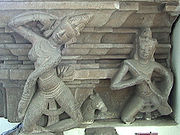
Apsaras in the art of Champa
Apsaras were also an important motif in the art of Champa, medieval Angkor's neighbor to the east along the coast of what is now central Vietnam. Especially noteworthy are the depictions of apsaras in the Tra Kieu Style of Cham art, a style which flourished in the 10th and 11th centuries A.D.
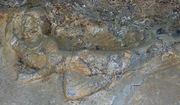
References
 This article incorporates text from a publication now in the public domain: Chisholm, Hugh, ed (1911). Encyclopædia Britannica (Eleventh ed.). Cambridge University Press.
This article incorporates text from a publication now in the public domain: Chisholm, Hugh, ed (1911). Encyclopædia Britannica (Eleventh ed.). Cambridge University Press.- Marchal, Sappho. Khmer Costumes and Ornaments of the Devatas of Angkor Wat. First English edition. Orchid Press, 2005. ISBN 978-974-524-057-5
- The Rig Veda in the English translation prepared by Ralph T.H. Griffith is available online at sacred-texts.com.
- The Mahabharata in the English translation prepared by Kisari Mohan Ganguli is available online at sacred-texts.com.
- The Monuments of the Angkor Group by Maurice Glaize is available online in English translation.
Footnotes
- ↑ Rig Veda, Book X, Hymn 95.
- ↑ Mahabharata, Book III: Vana Parva, Section 43.
- ↑ Mahabharata, Book I: Adi Parva, Section 71-72.
- ↑ Maurice Glaize, Monuments of the Angkor Group, p.37.
- ↑ Angkor Wat devata inventory - February 2010
- ↑ Sappho Marchal, Khmer Costumes and Ornaments of the Devatas of Angkor Wat.
See also
- Angkor Wat
- Architecture of Cambodia
- Art of Champa
- Devata
- Gandharva - Celestial male companions of the asparas
- Tennin, a Japanese development of Indian apsaras
- Vishnu
External links
- Chinese Apsaras depicted in Dunhuang Caves
- Comparison of Khmer Apsaras and Devata
- Costumes and Ornaments after the Devata of Angkor Wat by Sappho Marchal - Book review
- Indian Devata at Rajarani Temple in Orissa
- Japanese traditions of celestial maidens Tennin (apsara), Hiten (flying apsara), Tennyo (celestial maiden) & Karyobinga (bird body with angel head)
- Rice Goddesses of Indonesia, Cambodia and Thailand
|
|||||||||||||||||
